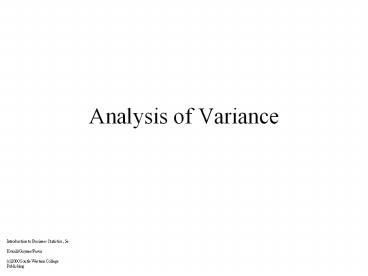Analysis of Variance - PowerPoint PPT Presentation
Title:
Analysis of Variance
Description:
Analysis of Variance Introduction to Business Statistics, 5e Kvanli/Guynes/Pavur (c)2000 South-Western College Publishing Assumptions The replicates are obtained ... – PowerPoint PPT presentation
Number of Views:131
Avg rating:3.0/5.0
Title: Analysis of Variance
1
Analysis of Variance
Introduction to Business Statistics, 5e
Kvanli/Guynes/Pavur (c)2000 South-Western
College Publishing
2
Assumptions
- The replicates are obtained independently and
randomly from each of the populations. - The replicates from each population follow a
(approximate) normal distribution. - The normal populations all have a common variance.
Introduction to Business Statistics, 5e
Kvanli/Guynes/Pavur (c)2000 South-Western
College Publishing
3
Measuring Variation
- SS(factor) measures between-sample
variation SS(between) - SS(error) measures within-sample variation
SS(within) - SS(total) measures the total variation in the
sample SS(factor) SS(error)
Introduction to Business Statistics, 5e
Kvanli/Guynes/Pavur (c)2000 South-Western
College Publishing
4
Determining Sum of Squares
Introduction to Business Statistics, 5e
Kvanli/Guynes/Pavur (c)2000 South-Western
College Publishing
5
Anova Table
Source df SS MS FFactor
k - 1 SS(factor) MS(factor) MS(factor)
Error n - 2 SS(error) MS(error) MS(error)To
tal n - 1 SS(total)
SS(factor)
MS(factor)
F
MS(factor)
k
-
1
MS(error)
SS(error)
MS(error)
n
-
k
Introduction to Business Statistics, 5e
Kvanli/Guynes/Pavur (c)2000 South-Western
College Publishing
6
Test for Equal Variances
Ho ?12 ?22 . ?k2 Ha At least 2
variances are unequal
Reject HO if H gt HTable A.14
Introduction to Business Statistics, 5e
Kvanli/Guynes/Pavur (c)2000 South-Western
College Publishing
7
Confidence Intervals inOne Factor ANOVA
Introduction to Business Statistics, 5e
Kvanli/Guynes/Pavur (c)2000 South-Western
College Publishing
8
Multiple Comparisons Procedure
Find Q?, k, ? using Table A.16 Determine
Place the sample means in order, from smallest to
largest. If two means differ by more than D, the
conclusion is that the corresponding population
means are unequal.
Introduction to Business Statistics, 5e
Kvanli/Guynes/Pavur (c)2000 South-Western
College Publishing
9
One-Factor ANOVA Procedure
- Requirements
- The replicates are obtained independently and
randomly from each of the populations. - The observations from each population follow
(approximately) a normal distribution. - The populations all have a common variance.
Introduction to Business Statistics, 5e
Kvanli/Guynes/Pavur (c)2000 South-Western
College Publishing
10
Ho ?1 ?2 ?k Ha not all ?s are equal
Reject Ho if F gt F?, k-1,n-1
Source df SS MS FFactor
k - 1 SS(factor) MS(factor) MS(factor)
Error n - 2 SS(error) MS(error) MS(error)To
tal n - 1 SS(total)
Introduction to Business Statistics, 5e
Kvanli/Guynes/Pavur (c)2000 South-Western
College Publishing
11
Randomized Block Design
The samples are not independent, the data are
grouped (blocked) by another variable. The
difference between the randomized block design
and the completely randomized design is that here
we use a blocking strategy rather than
independent samples to obtain a more precise test
for examining differences in the factor level
means.
Introduction to Business Statistics, 5e
Kvanli/Guynes/Pavur (c)2000 South-Western
College Publishing
12
Randomized Block Design
k number of factor levels in the design b
number of blocks in the design n number of
observations bk
Introduction to Business Statistics, 5e
Kvanli/Guynes/Pavur (c)2000 South-Western
College Publishing
13
Factor Hypothesis Test
Ho ?1 ?2 ?k Ha not all ?s are equal
Reject Ho if F gt F?, k-1, (k-1)(b-1)
Introduction to Business Statistics, 5e
Kvanli/Guynes/Pavur (c)2000 South-Western
College Publishing
14
Block Hypothesis Test
Ho ?1 ?2 ?b Ha not all ?s are equal
Reject HO if F gt F?, b-1, (k-1)(b-1)
Introduction to Business Statistics, 5e
Kvanli/Guynes/Pavur (c)2000 South-Western
College Publishing
15
Confidence IntervalDifference Between Two Means
Randomized Block (1- ?) 100 Confidence Interval
Introduction to Business Statistics, 5e
Kvanli/Guynes/Pavur (c)2000 South-Western
College Publishing
16
Multiple Comparisons ProcedureRandomized Block
X
-
X
gt D
i
j
Introduction to Business Statistics, 5e
Kvanli/Guynes/Pavur (c)2000 South-Western
College Publishing
17
Two-Way Factorial Design
Introduction to Business Statistics, 5e
Kvanli/Guynes/Pavur (c)2000 South-Western
College Publishing
18
Hypothesis Test Factor A
Ho Factor A is not significant Ha Factor A is
significant
Reject Ho,A if F1 gt F?, ?1, ?2
Introduction to Business Statistics, 5e
Kvanli/Guynes/Pavur (c)2000 South-Western
College Publishing
19
Hypothesis Test Factor B
Ho Factor B is not significant Ha Factor B is
significant
Reject Ho,B if F2 gt F?, ?1, ?2
Introduction to Business Statistics, 5e
Kvanli/Guynes/Pavur (c)2000 South-Western
College Publishing
20
Hypothesis Test Interaction
Ho Interaction is not significant Ha
Interaction is significant
Reject Ho,AB if F2 gt F?, ?1, ?2
Introduction to Business Statistics, 5e
Kvanli/Guynes/Pavur (c)2000 South-Western
College Publishing
21
Multiple Comparisons ProcedureTwo-Way Factorial
Design
Introduction to Business Statistics, 5e
Kvanli/Guynes/Pavur (c)2000 South-Western
College Publishing

